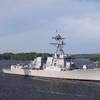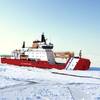Military Uses for High-Speed Vessels
High-speed aluminum vessels are well-recognized and established as providing excellent service in a number of capacities by both private and public operators. These uses include leisure travel and tours and mass transportation of passengers and vehicles. In recent years, the U.S. military has joined the ranks of high-speed vessel users by introducing U.S.-built aluminum twin-hull high-speed vessels for use as Theater Support Vessels (TSVs) and for training exercises. Despite a somewhat uncertain funding climate for these types of vessels in the military, they have performed exceptionally well with demonstrated benefits. The U.S. military has begun using (typically through charter arrangements) high-speed vessels (1) to transport troops and equipment to combat zones and (2) for military exercises. The increasing interest in high-speed vessels from the military has resulted in recent funding by the Congress of the Navy's Littoral Combat Ship program and the chartering of two TSVs described below. Despite this trend and the successful service of these vessels, the future of the TSV program remains uncertain at this time, as Congress has not appropriated funds for the design and construction of additional TSVs. High-speed vessels provide the military with a less expensive means of transporting large quantities of equipment and troops in a single voyage to combat areas and for training exercises. The use of such vessels in place of aircraft, where appropriate, allows the U.S. military to reserve its airlift capabilities for longer range missions. Moreover, high-speed vessels chartered to the MSC in particular may obtain a waiver from compliance with U.S. Coast Guard navigation and inspection requirements upon a finding that such waiver is in the interest of national defense. For example, the 98 m Westpac Express, constructed as a passenger vessel by Austal Ships Pty Ltd. of Western Australia, is presently operating under a time charter to the MSC for use by the Marine Corps' Third Marine Expeditionary Force. Unlike a bareboat charter (also known as a demise charter), a time charterer does not assume the responsibility for managing and operating the vessel; that responsibility remains with the vessel owner or its designated operator. The Westpac Express is based in Okinawa, Japan and, unlike other high-speed vessels used by the U.S. military, operated by an all-civilian crew. In addition to the pure military benefits, as recent events show, high-speed vessels may be used to provide humanitarian relief in remote corners of the world. In January 2005, the Westpac Express traveled 2,300 miles from its base in Okinawa to ferry over 600 tons of needed communications equipment to tsunami-ravaged Southeast Asia. In contrast, providing the humanitarian assistance by air would have required constant flights over a five or six-day period. In addition, the U.S. Army's Southern Command currently operates the TSV named Spearhead, or TSV-1X, which provides troop movement capabilities similar to those of the Westpac Express. This vessel is operated under a charter between the U.S. Army Tank Automotive and Armament Command and the vessel's builder and owner, Bollinger/Incat USA, LLC, a joint venture between Bollinger Shipyards of Lockport, Louisiana, and Incat Tasmania Pty, Ltd. of Tasmania. Bollinger/Incat also has constructed high-speed vessels chartered to the U.S. Navy. The most recent, named the Swift or HSV 2, is an enhanced version of its predecessor, the Joint Venture or HSV X-1. The Swift is chartered to the MSC and serves as a mine warfare command and support ship and experimental vessel for the Navy and Marine Corps. It is one of two high-speed vessels (the other being the Westpac Express) that are part of the 24 ships in the MSC's Special Mission Ships Program, and also has been used to provide humanitarian assistance to those countries affected by the tsunami in Southeast Asia. In 2003, the Department of Commerce, Bureau of Industry and Security (BIS), at the request of the Army, conducted an assessment of the economic benefits of a TSV building program for U.S. shipyards. At that time, the Army was committed to acquiring seven TSVs by 2008. The BIS study concluded that such a building program would add more than $1.3 billion to the U.S. economy and provide almost 3,000 new jobs at competitive wage rates. However, unlike the LCS program, the federal government has not specifically appropriated funds for further development and construction of non-combat high-speed vessels by the U.S. military for fiscal year 2006. One benefit available to existing and future high-speed ferry builders is a Department of Defense program that finances, among other things, the installation and maintenance of "national defense features" (e.g., reinforced decks, cranes and roll-on/roll-off ramps) on vessels through the National Defense Sealift Fund (NDSF). In fiscal year 2005, Congress appropriated over $1.2 billion to finance such activities. Fiscal year 2006 appropriations could reach $1.6 billion or more. The NDSF is used, in part, to install and maintain defense features on privately owned and operated U.S.-flag vessels. In order to qualify for such funds, vessel owners must submit offers to have defense features installed and maintained on their vessels. Once a determination is made that the offer is economically sound, the federal government will approve the expenditure of the funds.
The funds are designed to compensate the vessel owner at a fair and reasonable rate for the following: The costs to build, procure, and install defense features on the vessel. The costs to periodically maintain and test the defense features. Increased costs of operation or any lost revenue attributable to the installation or maintenance of the defense features on the vessel. Any additional costs associated with the defense features as determined by the contract.
Payments under the contract may be made either in advance in a lump sum, in which case a security interest in the vessel by way of a preferred mortgage is required, or annually. As consideration for such financing, the vessel owner agrees to make the vessel available to the Secretary of Defense, fully crewed and ready for sea, at any time and at any point determined by the Secretary of Defense.
Despite the public funding constraints, incentives are available, including the NDSF, for private builders and operators interested in chartering high-speed vessels to the military. The success of the Westpac Express and the Spearhead have set the stage for future use of these vessels for both theater support and training.













